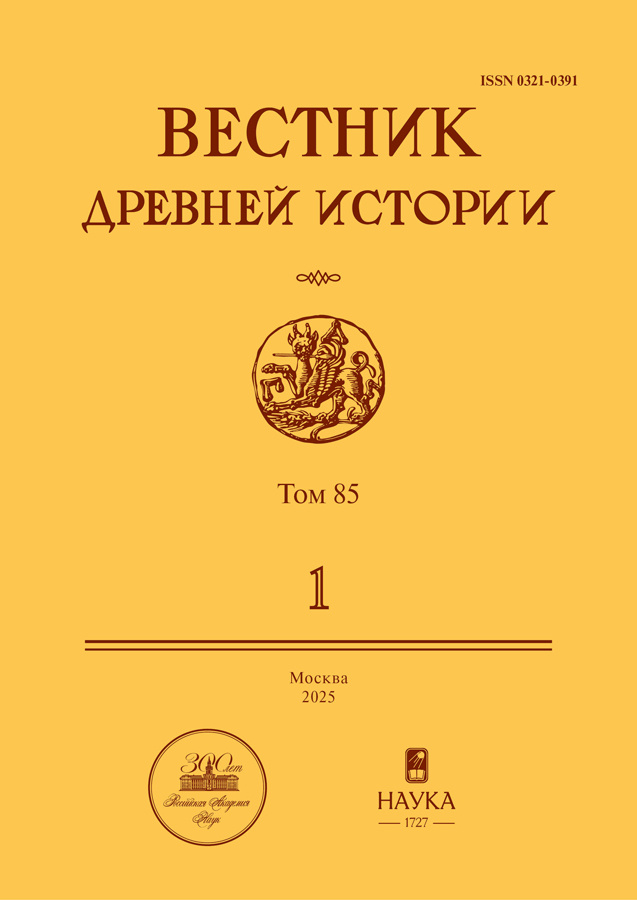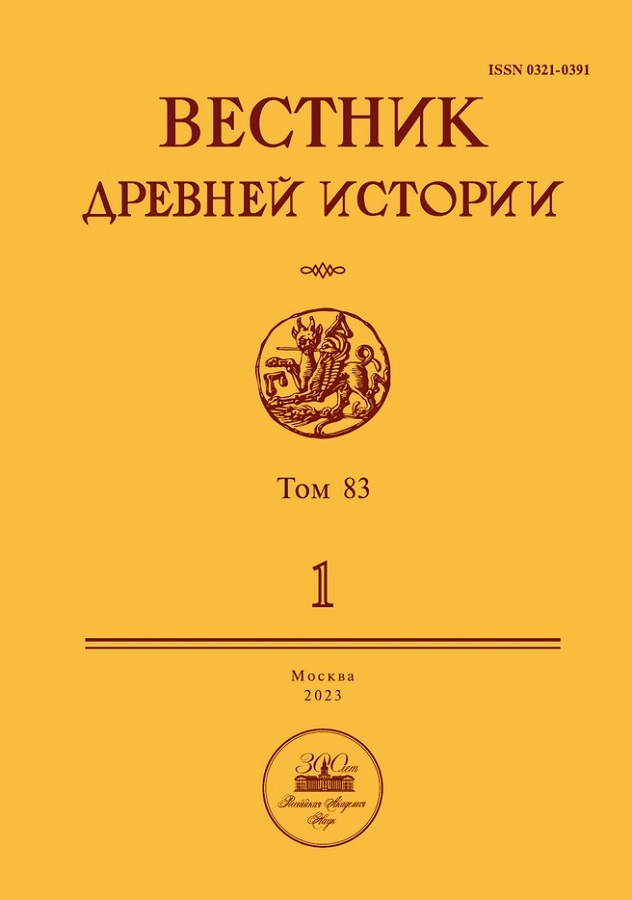“Daiva Inscription” of Xerxes: Historical Account, Ideological Statement, or Propaganda?
- Authors: Yakubovich I.S.1
-
Affiliations:
- Researcher at the University
- Issue: Vol 83, No 1 (2023)
- Pages: 5-26
- Section: Articles
- URL: https://rjraap.com/0321-0391/article/view/648561
- DOI: https://doi.org/10.31857/S032103910021908-1
- ID: 648561
Cite item
Abstract
The so-called “Daiva inscription” of Xerxes found in Persepolis addresses the activity of this Achaemenid Persian king in two lands, one of which is said to have been in commotion, while the other is alluded to have been characterized by unacceptable religious practices. Xerxes stresses his involvement in the restoration of order in both countries but does not mention their names. Egypt, Babylon, Greece and Bactria were all adduced as candidates by 20th-century scholars, while the recent mainstream scholarship tends to interpret the same accounts as abstract ideological statements without an anchor in time or space. The new approach advocated in this paper assumes that Xerxes resorted to historical narratives only in order to provide his own apologetic version of embarrassing events. In particular, his self-professed involvement in the destruction of the cults of evil gods is to be interpreted as a twisted account of the destruction of the Acropolis of Athens by the Persian army in 480 BCE. In the wake of the disastrous war against the Greeks, Xerxes strove to present it as a successful special operation against the Greek deities.
Full Text
About the authors
Ilya Sergeevich Yakubovich
Researcher at the University
Author for correspondence.
Email: yakubovi@staff.uni-marburg.de
ORCID iD: 0000-0002-7576-7930
Germany, Marburg
References
- Abaev, V.I. 1963: [Column Five of the Bisitun Inscription of Darius I and the Daiva Inscription of Xerxes]. Vestnik drevney istorii [Journal of Ancient History] 3, 113—118.
- Абаев, В.И. Пятый столбец Бехистунской надписи Дария I и антидэвовская надпись Ксеркса. ВДИ 3, 113-118.
- Abdi, К. 2007: The ‘Daiva’ Inscription Revisited. Nāme-ye Iran-e Bāstān 6/1-2, 45-74.
- Baker, A.E., Hengeveld, K. (eds.) 2012: Linguistics. Oxford.
- Bianchi, U. 1977: L’inscription «des daivas» et le zoroastrisme des Achéménides. Revue de I'histoire des religions 192/1, 3—30.
- Boyce, M. 1982: A History of Zoroastrianism: Zoroastrianism under the Achaemenians. Leiden.
- Briant, P. 2002: From Cyrus to Alexander: A History of the Persian Empire. Winona Lake (IN).
- Bridges, E. 2015: Imagining Xerxes: Ancient Perspectives on a Persian King. London.
- Cohoon, J.W. (ed.) 1932: Dio Chrysostom, Discourses 1—11. Cambridge (MA).
- Dandamaev, M.A. 1976: Persien unter der ersten Achämeniden (6. Jahrhundert v. Chr.). Wiesbaden.
- Dandamaev, M.A. 1985: Politicheskaya istoriya Akhemenidskoy derzhavy [Poltical History of the Achaemenid Empire]. Moscow.
- Дандамаев, M.A. Политическая история Ахеменидской державы. М. David, J. 2017: Achaemenid Propaganda and Oral Tradition: A Reassessment of Herodotus’ Early Persian Logoi. In: B. Halpern, K.S. Sacks (eds.), Cultural Contact and Appropriation in the Axial- Age Mediterranean World: A Periplos. Leiden, 60-82.
- Filippone, E. 2010: Xerxes Persepolis h, § 4 in the Light of the Old Persian Information Structure. In: M. Macuch, D. Weber, D. Durkin-Meisterernst (eds.), Ancient and Middle Iranian Studies, Proceedings of the 6th European Conference of Iranian Studies, held in Vienna 18—22 September 2007. Wiesbaden, 61-76.
- Gnoli, G. 2011: Daivadāna. In: Encyclopedia Iranica. URL: https://iranicaonline.org/articles/ daivadana-lit; accessed on: 21.01.2023.
- Hartmann, H. 1937: Zur neuen Inschrift des Xerxes von Persepolis. Orientalistische Literaturzeitung 40/3, 145-160.
- Henkelman, W.F.M. 2008: The Other Gods Who Are: Studies in Elamite-Iranian Acculturation Based on the Persepolis Fortification Texts. Leiden.
- Herzfeld, E. 1937: Xerxes’ Verbot des Daiva-Cultes. Archaologische Mitteilungen aus Iran 8, 56—77.
- Hintze, A. 2015: Zarathustra’s Time and Homeland: Linguistic Perspectives. In: M. Strausberg, Y.S. Vevaina (eds.), The Wiley-Blackwell Companion to Zoroastrianism. Oxford, 31—38.
- Huayna Ávila, C.S. 2020: Some Thoughts on Xerxes’s “Daiva" Inscription and its Interpretation. Antiguo Oriente 18, 119-186.
- Hutter, M. 2021: Religions in the Empire. In: B. Jacobs, R. Rollinger (eds.), A Companion to the Achaemenid Persian Empire. Vol. II. Hoboken (NJ), 1285-1302.
- Jacobs, B. 2014: Historische Aussagen in den Achämenideninschriften im Licht sich wandelnder Legitimationsstrategien. In: S. Gaspa, A. Greco, D. Morandi Bonacossi, S. Ponchia, R. Rollinger (eds.), From Source to History: Studies on Ancient Near Eastern Worlds and Beyond Dedicated to Giovanni Battista Lanfranchi on the Occasion of His 65th Birthday on June 23, 2014. Münster, 341—352.
- Konijnedijk, R. 2021: Legitimization of War. In: B. Jacobs, R. Rollinger (eds.), A Companion to the Achaemenid Persian Empire. Vol. II. Hoboken (NJ), 1141-1150.
- Kuhrt, A., Sherwin-White, S.M. 1987: Xerxes’ Destruction of Babylonian Temples. In: H.W.A.M. Sancisi-Weerdenburg, A. Kuhrt (eds.), Achaemenid History II. The Greek Sources: Proceedings of the Groningen 1984 Achaemenid History Workshop. Leiden, 69—78.
- Kuhrt, A. 2014: Reassessing the Reign of Xerxes in the Light of New Evidence. In: M. Kozuh, W.F.M. Henkelman, Ch.E. Jones, Chr. Woods (eds.), Extraction and Control: Studies in Honor of Mattew W. Stolper. Chicago, 163-170.
- Lévy, I. 1939: L’inscription triomphale de Xerxès. Revue historique 185/1, 105-122.
- Nyberg, H.S. 1938: Die Religionen des alien Irans. Leipzig.
- Olmstead, A.T. 1948: History of the Persian Empire. Chicago.
- Petrovic, I. 2014: Posidippus and Achaemenid Royal Propaganda. In: R. Hunter, A. Rengakos, E. Sistakou (eds.), Hellenistic Studies at a Crossroads: Exploring Texts, Contexts and Metatexts. Berlin, 273-300.
- Riminucci, Ch. 2006: Les daiva dans 1'inscription de Xerxès (XPh): entités étrangères ou anciennes divinités iraniennes? In: A. Panaino, A. Piras (eds.), Proceedings of the 5th Conference of the Societas Iranologica Europaea Held in Ravenna, 6—11 October 2003. Vol. I. Ancient and Middle Iranian Studies. Milan, 183—200.
- Rollinger, R. 2014: Thinking and Writing about History in Teispid and Achaemenid Persia. In: K.A. Raaflaub (ed.), Thinking, Recording, and Writing History in the Ancient World. Oxford, 187-212.
- Sancisi-Weerdenburg, H.W.A.M. 1980: Yauna en Persai. Grieken en Perzen in een ander perspectief. PhD thesis. Leiden.
- Sancisi-Weerdenburg, H.W.A.M. 1999: The Persian Kings and History. In: Ch. Shuttleworth Kraus (ed.), The Limits of Historiography: Genre and Narrative in Ancient Historical Texts. Leiden, 91—112.
- Scheer, T.S. 2003: Die geraubte Artemis. Griechen, Perser, und die Kultbilder der Götter. In: M. Witte, S. Alkier (Hrsg.), Die Griechen und der Vordere Orient: Beiträge zum Kultur- und Religionskontakt zwischen Griechenland und dem Vorderen Orient im 1. Jahrtausend v. Chr. Goettingen, 59—86.
- Schmidt, E.F. 1953: Persepolis I: Structures, Reliefs, Inscriptions. Chicago.
- Schmitt, R. 1991: The Bisitun Inscription of Darius the Great: Old Persian Text. London.
- Schmitt, R. 2000: The Old Persian Inscription of Naqsh-i Rustam and Persepolis. London.
- Schmitt, R. 2009: Die altpersischen Inschriften der Achaimeniden. Wiesbaden.
- Schmitt, R. 2014: Wörterbuch der altpersischen Königsinschrften. Wiesbaden.
- Shenkar, M. 2017: The Great Iranian Divide: Between Aniconic West and Anthropomorphic East. Religion 47/3, 378-398.
- Skærvø, P.O. 2012: The Spirit of Zoroastrianism. New Haven-London.
- Stronach, D. 1965: Excavations at Pasargadae: Third Preliminary Report. Iran 3/1, 9-40.
- Tavernier, J. 2004: Some Thoughts on Neo-Elamite Chronology. ARTA: Achaemenid Research on Texts and Archaeology 3, 1-44.
- Tucker, E. 2022: Lexical Variation in Young Avestan: The Problem of the ‘Ahuric’ and ‘Daevic’ Vocabularies Revisited. In: M. Bianconi, M. Capano, D. Romagno, F. Rovai (eds.), Ancient Indo-European Languages Between Linguistics and Philology: Contact, Variation, and Reconstruction. Leiden, 254—275.
Supplementary files











